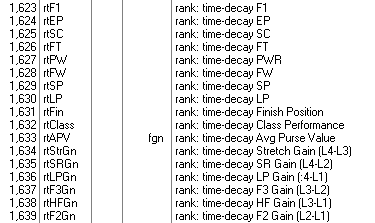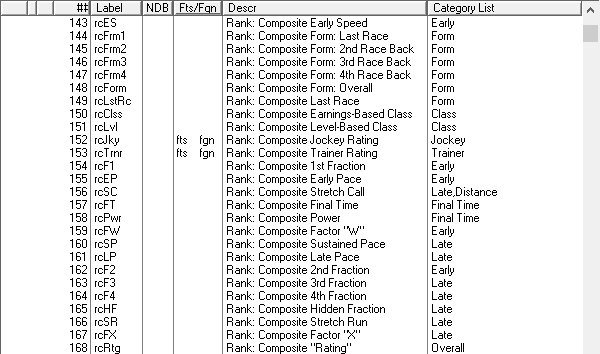-
 RanchWest
503If you divided the total by the number of races it could be useful! — Mark
RanchWest
503If you divided the total by the number of races it could be useful! — Mark
That would give an average SR, but that wasn't the point of the calculation.
Dave's idea is to take the sorted 6th highest figure and look for an 8/1+ horse that is within that 1st to 6th range. I think Steve probably gets it now. -
 Dave Schwartz
422Dave's idea is to take the sorted 6th highest figure and look for an 8/1+ horse that is within that 1st to 6th range. I think Steve probably gets it now. — RanchWest
Dave Schwartz
422Dave's idea is to take the sorted 6th highest figure and look for an 8/1+ horse that is within that 1st to 6th range. I think Steve probably gets it now. — RanchWest
Not 6th but Top 6.
What is it Dave said in one of his workshops "Often wrong, seldom in doubt". — Steven
One of my favorite quotes, along with one from the TV series, Billions: "I am not uncertain." -
 Dave Schwartz
422It's like what All-Ways software does with listing the top 10 Bris speed ratings. — Mark
Dave Schwartz
422It's like what All-Ways software does with listing the top 10 Bris speed ratings. — Mark
Exactly! -
 Gregory Byrnes
5I guess the question is after you have correctly predicted the odds on the top 3 or 4 horses in a race, and knowing the top two odds horses win the lions share of races, what do you do with this? Is this your contender list based on your predicted odds? Or do you have a separate contender list from which you play your lowest odds contender(s) or conversely do you work from the other ends of your contenders list using the predicted higher odds contender(s)? I guess I'm presuming there are three or four contenders in a race.
Gregory Byrnes
5I guess the question is after you have correctly predicted the odds on the top 3 or 4 horses in a race, and knowing the top two odds horses win the lions share of races, what do you do with this? Is this your contender list based on your predicted odds? Or do you have a separate contender list from which you play your lowest odds contender(s) or conversely do you work from the other ends of your contenders list using the predicted higher odds contender(s)? I guess I'm presuming there are three or four contenders in a race. -
 Tom
90What I do is first look for overlays in the top 3 or 4. If I find a decent one, say my 7-2 line 3rd horse is 8-1, I'm really interested. If noting jumps out, I look at the lowest line horse and disparage it. Why can't it win, what's negative in its record, why can't it win? Often, the lowest line horse is just "terrible" on paper, all of its good numbers coming from a turf marathon on yielding grass a year ago in a stakes race and today it's in a 5.5F claimer on dirt. I may mentally add a half point for each major negative I find, say taking the horse from 9-5 to 3-1. Or just say "no thanks" and move on.
Tom
90What I do is first look for overlays in the top 3 or 4. If I find a decent one, say my 7-2 line 3rd horse is 8-1, I'm really interested. If noting jumps out, I look at the lowest line horse and disparage it. Why can't it win, what's negative in its record, why can't it win? Often, the lowest line horse is just "terrible" on paper, all of its good numbers coming from a turf marathon on yielding grass a year ago in a stakes race and today it's in a 5.5F claimer on dirt. I may mentally add a half point for each major negative I find, say taking the horse from 9-5 to 3-1. Or just say "no thanks" and move on.
Since only the last line is used, I also double check to see if a potentially top rated horse got left out due to a bad last race that is really excusable.
If I have a 8-5 top horse, and the next horses are bunched, say 4-1, 9-2, 5-1....I might consider a part wheel over them, or, if the top horse is suspect, I might bet 2-3 others to win or W/P. The handicapping begins once the line is ready. Funny, it is much like the process Beyer outlined in his chapter "Putting it All Together" in his book Picking Winners," and just yesterday dnglfnk at PA talked about HE uses that very chapter in his process. -
 RanchWest
503I guess the question is after you have correctly predicted the odds on the top 3 or 4 horses in a race, and knowing the top two odds horses win the lions share of races, what do you do with this? — Gregory Byrnes
RanchWest
503I guess the question is after you have correctly predicted the odds on the top 3 or 4 horses in a race, and knowing the top two odds horses win the lions share of races, what do you do with this? — Gregory Byrnes
Wait. -
 RanchWest
503Hope I didn't come across as terse. Just getting back to this.
RanchWest
503Hope I didn't come across as terse. Just getting back to this.
I think you have to give prime consideration to the top 3 UOL horses. That should get a lot of winners. Then find your most successful contender process. Unless you feel strongly about one of your other contenders, you know that one of the three UOL low odds horses that is on your contenders list will win a lot of races. Then you have to look at which of these contenders will be aided by the pace setup. My contenders list needs to include both early and late horses. Will the race run early, late or chaos (late)? That's what I am doing. -
 Jim Michalak
41Tom: what is the current points classification system? In the instructions it is 10-6-4-2-1 for horses rated 1-5 in the following categories: last race speed, average class or trainer win % if you have premium, prime power, early pace and late pace. For Aqeduct you changed it to a 74 point total with more emphasis on prime power and less on average class with early pace and late pace left out. Was that system just for Aqeduct or is that now the system for all tracks? Thanks for your help and a great tool!
Jim Michalak
41Tom: what is the current points classification system? In the instructions it is 10-6-4-2-1 for horses rated 1-5 in the following categories: last race speed, average class or trainer win % if you have premium, prime power, early pace and late pace. For Aqeduct you changed it to a 74 point total with more emphasis on prime power and less on average class with early pace and late pace left out. Was that system just for Aqeduct or is that now the system for all tracks? Thanks for your help and a great tool! -
 Jim Michalak
41Tom: your ultimate odds line was all over Early Voting for the Preakness. Nice work!
Jim Michalak
41Tom: your ultimate odds line was all over Early Voting for the Preakness. Nice work! -
 Tony Kofalt
407Tom is a very intuitive player. I have no idea how he does at the windows but I have to believe he's a winner
Tony Kofalt
407Tom is a very intuitive player. I have no idea how he does at the windows but I have to believe he's a winner -
 Dave Schwartz
422I'm trying to figure out how to share this photo. I'll see what I can come up with because the "Image" and "Upload Files" ways aren't working at the moment. User error, most likely. — Lawrence
Dave Schwartz
422I'm trying to figure out how to share this photo. I'll see what I can come up with because the "Image" and "Upload Files" ways aren't working at the moment. User error, most likely. — Lawrence
Before I tell you how please I am to see you here - just pretend I didn't say that - let me tell you the easiest way to upload a file. OH! You figured it out!
I LOVE what you are doing.
Let me know how I can help.
BTW, I will predict that what you find from your spreadsheet work will work but not the way you think.
I'll guess that you will find that the obvious horses are what have been dubbed BOLOs by the locals. Can't recall at the moment whether it was @RanchWest, @Biniak, or @Steven, but it was definitely one of them
A BOLO is a BET AGAINST LOW ODDS horse.
Congratulations on some nice work.
#BOLO -
 RanchWest
503Can't recall at the moment whether it was RanchWest, @Biniak, or @Steven, but it was definitely one of them
RanchWest
503Can't recall at the moment whether it was RanchWest, @Biniak, or @Steven, but it was definitely one of them
A BOLO is a BET AGAINST LOW ODDS horse. — Dave Schwartz
I think it was Biniak who dubbed it BA LO. -
 RanchWest
503LeBlanc IVH "false favourite." — Lawrence
RanchWest
503LeBlanc IVH "false favourite." — Lawrence
Have you found this to be effective? On Sunday, 5/22/22, I used a BRIS par drop of greater than 3 and and a morning line of less than 3.01. That did not pan out very well on the day. Of 19 horses, there were 7 winners. There was only one dropper of greater than 12 par points and at a drop of 21 that one lost on 23 days rest. 6 of the 7 winners were dropping either 5 or 6 points. There were only 3 losers dropping 5 or 6 points.
The payoffs ranged from $2.50 to $6.80, so maybe that's just something to live with since 12 of 19 lost.
Do you have any suggestions as to a way to get this to work better? There was a winner that dropped 12 points. I looked at days away and I didn't locate anything effective. Should I only look at the massive droppers? Or was my sample size just too small?
Or do you think this is only useful as part of an odds line? -
 Tony Kofalt
407
Tony Kofalt
407
Thank you for walking us through your process Lawrence. Very clever use of combining some software to get strong results. Please keep us updated. -
 Dave Schwartz
422Imitation is the most sincere form of flattery. :)
Dave Schwartz
422Imitation is the most sincere form of flattery. :)
I got them from Benter. ;)
Here are the time decay factors in HSH.

Here are the Composite Factors.

Take a look at Time-Decay Stretch Run and the like. -
 RanchWest
503I got the time decayed idea from how the RDSS — Lawrence
RanchWest
503I got the time decayed idea from how the RDSS — Lawrence
Yes, Ted told me how to do the CSR, so I applied the logic to my BRIS file. I also did it with the 2f, 4f, 6f and LT pace figures. I see Dave has the time decay EP and LP... I would think those are very useful numbers. While a high LP number is not mandatory, a poor LP figure is a very suspect horse from what I have seen.
Please register to see more
Forum Members always see the latest updates and news first. Sign up today.









